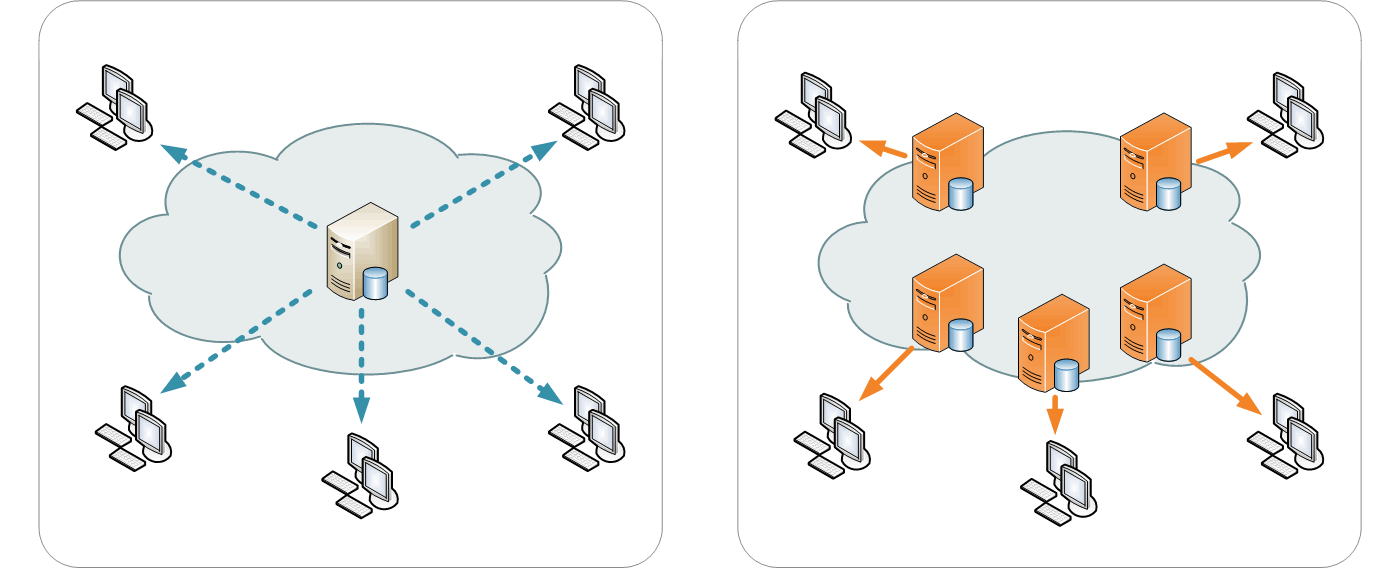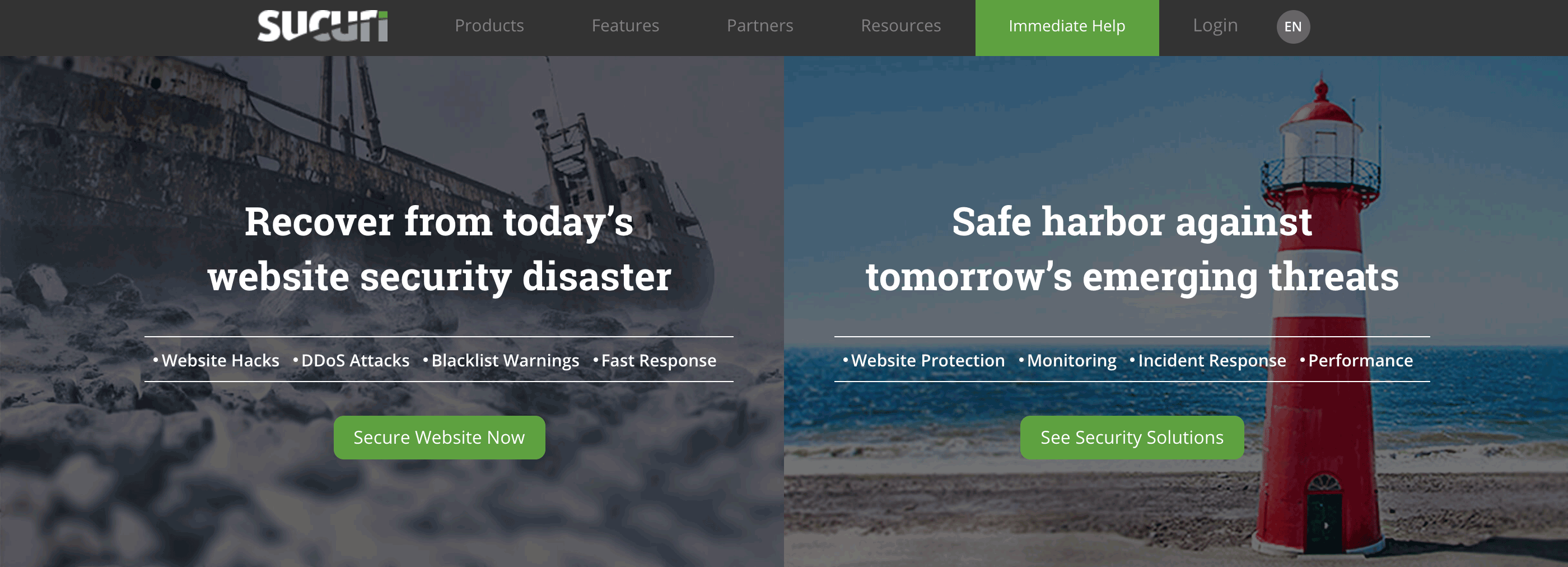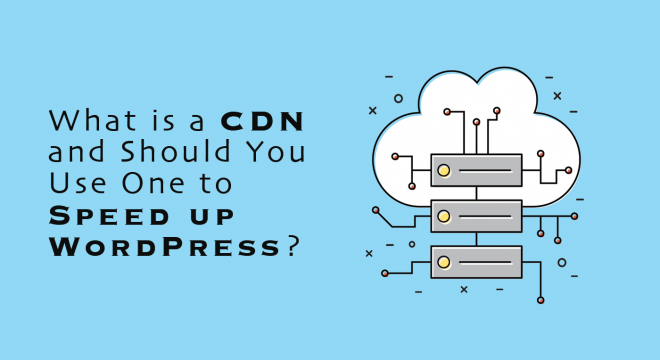WIth a traditional hosting service, website load time depends on the physical distance between the user and the hosting servers.
But with a CDN, users all over the world can have access to your site at faster speeds.
In this post, I’ll cover questions including: what is a CDN, what are its benefits and should you use one to help improve your website’s load time.
What is a CDN: Definition
A Content Delivery Network (CDN) is a global network of connected server clusters that provide speedy delivery of website content in each of the server locations.
When all web traffic for a site goes through a single server, the server can become overloaded, increasing the time it takes your site to load and reducing its performance.
A website also runs on a single server in one country. Having to rely on only that one server means visitors from the other side of the world will experience increased load times.
The time needed for a server to respond to a request is called latency, and latency increases as the distance increases between a server and a user.
A CDN balances the server load and improves page loading times by providing more servers globally, which lends a website more access points to help manage traffic flow and reduce latency. This increase in site speed also provides a better user experience.
What is a CDN: Structure
A Content Delivery Network is comprised of a series of linked servers with two distinct components: the origin server and the proxy servers.
The central component of the CDN is the origin server which all servers take instruction from and which contains all the most up-to-date site content. The origin server is the single source of truth in the CDN.
However, if all web traffic went through the origin server, the purpose of the CDN would be defeated.
The workhorses of the CDN are the edge, or proxy, servers that store static content such as images, stylesheets and JavaScript files through a caching system.

These edge servers are located all around the globe at locations called Points of Presence (PoP) and a CDN will have a full list of their PoP on their network page.
It should be noted that a CDN does not replace a web host but rather complements it to enhance performance. If you don’t have a central server to host your files on, your website doesn’t exist.
What is a CDN: Usage
Implementing a CDN can have multiple benefits for your website, your user base and your peace of mind.
Site Speed
On a traditional web hosting environment, all web traffic comes and goes through a single server for all its visitors. If there’s a huge surge in activity, this can severely slow down a site.
A slow website can have negative, lasting effects. When sites are slow:
- SEO rankings drop. Page speed is a factor in how well your website performs in a search engine algorithm.
- Users lose interest extremely quickly.
- Trust is broken between the website and users who don’t find the site reliable.
- Conversion rate decreases because users aren’t willing to wait and don’t have enough trust in your website or business to complete the transaction.
With decreased latency, traffic will be faster for users all over the world, enabling you to grow your business globally. This is a major benefit of improving site speed with a CDN.
Security
You may be wondering, “What is a CDN supposed to do about security and all these servers?”
Because of the distributed nature of a CDN, obtaining one means your website’s security increases.
Attacks can happen on all servers, but if a proxy server is attacked by a malicious user, the important files on the origin server are still preserved.

A CDN can also help mitigate against Distributed Denial of Service (DDoS) attacks that aim to overwhelm your system with traffic, making it impossible for a service to be delivered. If a single edge server goes down, the other parts of the network will still continue to function, which preserves your trust and reputation with users elsewhere.
A CDN can also implement SSL certificates which ensure encryption between edge servers and the origin server.
Cheaper Hosting
Having users load static content from servers requires a lot of bandwidth and resources which your hosting company will charge you for if you exceed them.
By storing the static content on the edge servers, you can reduce the bandwidth used on your origin server. This could save you from a huge bill or overage charges. But, you will still have to pay for the CDN service.
What is a CDN: Recommendations
Not every website needs a CDN. If you’re trying to decide if it’s right for you, here are a few elements to consider.
Traffic
In order to justify a CDN that will speed up your site in all parts of the globe, consider how much traffic you get. If you get a lot, the a CDN would make a difference.
All good CDN have load-balancing features for maintaining large spikes in site traffic. But, when and where are those occurring for you?
What type of traffic does your site usually accrue – local or global?
If your traffic is contained to a certain area, purchasing PoP access halfway across the world may not be a good use of your funds. That is, unless you want to expand to a global audience.
Does your site experience downtime at all?
If you’re not experiencing issues due to traffic, your site probably isn’t overloaded enough to warrant a CDN.
Site Size
Consider the size of your website and how it affects site performance.
Do you have a lot of pages and images? If not, using a CDN may not help increase site performance by much because your site isn’t a difficult one to handle.
Also, do you expect your site to grow and expand in the future?
If you’re expecting a change in site size, a CDN might be good fit. A cloud-hosting server can also help distribute traffic, as needed.
If you’re planning any sort of huge launch that will drive a ton of traffic to your site in a short period of time, you can prepare your infrastructure beforehand with a CDN. That way, you don’t have to scramble only after your site experiences a lot of downtime and missed leads.
Contents
When your user visits your website for the first time, they load every image and resource from your site into their browser. That’s asking a lot if you have a ton of uncompressed and high-quality images, or scripts.
There are of course plugins that can help optimize your site resources. But, a CDN may still be worth looking into, especially if pictures are your main content such as on a photography or portfolio website.
What is A CDN: A Summary
There’s a lot to consider when deciding if a CDN is the best fit for your site. But, it’s good to be aware of all your options.
Here’s a quick guide if you’re having trouble deciding:
You should consider a CDN if:
- You have a traffic-heavy site
- Lots of media is stored on your site
- Your business is expected to grow or drastically increase in activity
You can probably hold off from getting a CDN if:
- You have a small site
- A global audience isn’t your focus or you have a local audience
- You don’t have a lot of media on your site
Of course, it’s not a one time decision. Maybe you don’t need a CDN now, but you may need to consider your options later on. When you do, a few trusted WordPress CDN providers to look into include Cloudflare, Sucuri, and StackPath (formerly MaxCDN).
Secure the Area
If your hosting isn’t set up for increases in your website’s traffic or activity, a Content Delivery Network is crucial to consider.
Not only will it help your site be more user-friendly, but you’ll also have peace of mind knowing your website is safer and performing at its absolute best.
Do you want to set up a Content Delivery Network for your site? Do you still have burning questions to answer “What is a CDN?” Feel free to share your thoughts and questions in the comments below.





























Well said! 😉
Thank you so much for your feedback!